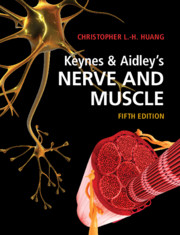Book contents
- Keynes & Aidley’s Nerve and Muscle
- Keynes & Aidley’s Nerve and Muscle
- Copyright page
- Dedication
- Contents
- Preface
- Acknowledgements
- Abbreviations used in the text
- 1 Structural Organisation of the Nervous System
- 2 Resting and Action Potentials
- 3 Background Ionic Homeostasis of Excitable Cells
- 4 Membrane Permeability Changes During Excitation
- 5 Voltage-Gated Ion Channels
- 6 Cable Theory and Saltatory Conduction
- 7 Neuromuscular Transmission
- 8 Synaptic Transmission in the Nervous System
- 9 The Mechanism of Contraction in Skeletal Muscle
- 10 The Activation of Skeletal Muscle
- 11 Excitation–Contraction Coupling in Skeletal Muscle
- 12 Contractile Function in Skeletal Muscle
- 13 Cardiac Muscle
- 14 Ion Channel Function and Cardiac Arrhythmogenesis
- 15 Smooth Muscle
- Further Reading
- References
- Index
13 - Cardiac Muscle
Published online by Cambridge University Press: 07 November 2020
- Keynes & Aidley’s Nerve and Muscle
- Keynes & Aidley’s Nerve and Muscle
- Copyright page
- Dedication
- Contents
- Preface
- Acknowledgements
- Abbreviations used in the text
- 1 Structural Organisation of the Nervous System
- 2 Resting and Action Potentials
- 3 Background Ionic Homeostasis of Excitable Cells
- 4 Membrane Permeability Changes During Excitation
- 5 Voltage-Gated Ion Channels
- 6 Cable Theory and Saltatory Conduction
- 7 Neuromuscular Transmission
- 8 Synaptic Transmission in the Nervous System
- 9 The Mechanism of Contraction in Skeletal Muscle
- 10 The Activation of Skeletal Muscle
- 11 Excitation–Contraction Coupling in Skeletal Muscle
- 12 Contractile Function in Skeletal Muscle
- 13 Cardiac Muscle
- 14 Ion Channel Function and Cardiac Arrhythmogenesis
- 15 Smooth Muscle
- Further Reading
- References
- Index
Summary
The propagation of action potentials through successive regions of the heart can be clinically monitored by electrocardiographic recording. The cardiac action potential typically comprises Phase 0 upstroke, early Phase 1 recovery, Phase 2 plateau and Phase 3 repolarisation to Phase 4 electrical diastole. These are driven respectively by inward Na+, early K+ transient outward, inward Ca2+, rapid and slow outward K+ currents, and inward rectifying K+ currents. The inward Ca2+ currents trigger Ca2+-induced release of sarcoplasmic reticular Ca2+ by cardiac ryanodine receptors, thereby initiating excitation-contraction coupling leading to contractile activation. With repolarisation, this is reversed through Ca2+-ATPase-mediated Ca2+ reuptake into the sarcoplasmic reticulum, and electrogenic Na+-Ca2+ exchange expelling Ca2+ into the extracellular space. These processes are modulated by feedforward autonomic, sympathetic and parasympathetic triggering of specific G-protein signaling pathways, involving their respective transmitters norepinephrine and acetylcholine. Conversely, cytosolic Ca2+ exerts feedback effects on the initiating Na+ current generation.
Keywords
- Type
- Chapter
- Information
- Keynes & Aidley's Nerve and Muscle , pp. 200 - 224Publisher: Cambridge University PressPrint publication year: 2020



